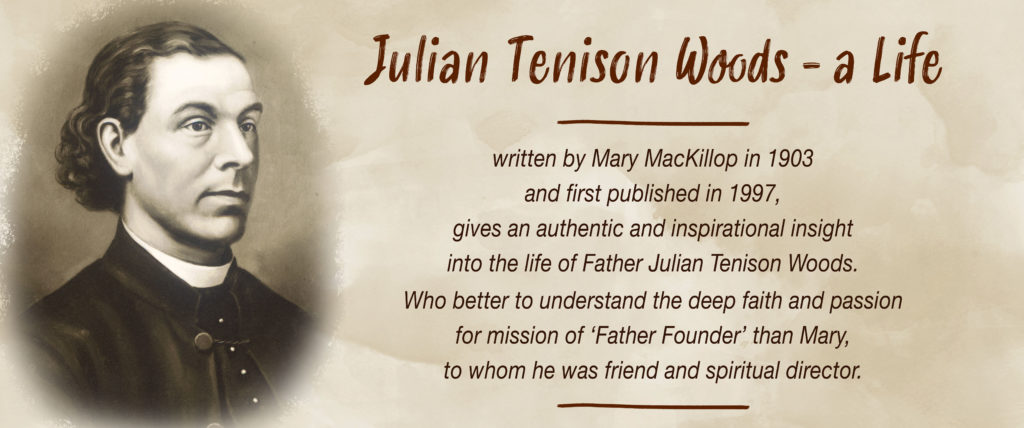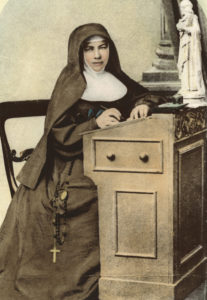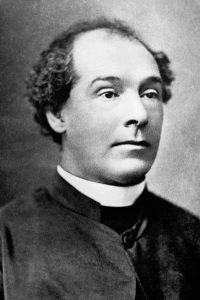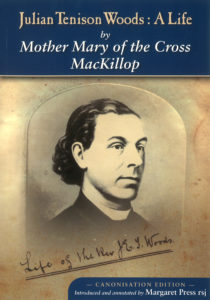
Chapters 9th, 10th and 11th
After the death of the Bishop [Murphy], the diocese was administered by the Vicar General, Father Ryan… [He] was well acquainted with the staunch old Catholics most of them Scotch – in the Penola district. [1]

Mr Cameron was the squatter who owned Penola Station and gave the land on which the church was built… The rich squatters could educate their families without much difficulty, but the poorer classes who were employed by them, and the trades people who began to settle around, were unable to procure teachers for their children.[2]
The zealous pastor [Father Julian Tenison Woods] made many attempts to get instructors. [3]
Dr Geoghegan, Vicar General of Melbourne, succeeded Dr Murphy… The new Bishop ‘took possession of his See on the Feast of All Saints, and ‘commenced a crusade for Catholic Education,’ says Cardinal Moran. This gave great satisfaction to Father Woods… The first Bishop of Adelaide had rejected state aid to Religion; the second determined if possible to obtain the abolition of state aid to any school. Let everyone support his own school, then there would be no necessity for an Education Grant… [4]
The Bishop visited [the South East] in June… [He] gave a short Mission, and spoke of the necessity of Catholic Schools at every place he visited… greatly to the satisfaction of Father Woods… [5]
The memory of Father Woods seems embalmed in the district. During the ten years he attended it, his advice was sought by people of all classes, and his correspondence became very large. Whoever wrote to him was sure of a courteous reply. Many letters are still in existence on various subjects, and all charming reading. What a many-sided mind the man must have had. [6]

In all his labours and troubles, however, he still found time for his scientific pursuits… Before he was removed from Penola, he had become Fellow of the Royal Geographical Society, Fellow of the Geological Society, of the Linnean Society, of the Royal Society of Victoria, Honorary Member of several Institutes and President of one. He humorously said he had an alphabet after his name… [7]
Visitors to Penola were delighted with the many specimens of stone he possessed, as well as with his beautiful garden where choice and rare shrubs flourished around the stone church of St Joseph. These beautiful plants and trees had been brought many a mile and much care was bestowed on them… [8]
The Education Question had always been a source of anxiety, a cause of contention in every part of Australia. Bishop Murphy struggled hard (as did each Bishop in his turn) to secure education for the Catholic children. At one time, his Lordship thought he would try to get a few Sisters of Mercy for Adelaide, but there was no money available to send to Europe… [9]
On the Feast of All Saints in the same year, the first ‘Pastoral Address of the Archbishop and Bishops of Australia’ was published. (The Synod was held in October.) The Pastoral contained these words:
For reasons obvious to every well-instructed Catholic, we must have for our children Catholic schools, Catholic teachers, and, as far as we can supply them, Catholic books. Catholics must secure for their children above all things a religious education…Their children must, in school, breathe a Catholic atmosphere. [10]
What pleasure this pastoral gave earnest Catholics may be easily imagined; it must have given great encouragement to the priests. [11]

This extract is taken from:
Chapters 9th, 10th and 11th of Julian Tenison Woods: A Life has been used with the kind permission of the Trustees of the Sisters of Saint Joseph 1997 and the publishers, St Paul’s Publications.
If you would like to read the full text, including an informative Introduction, footnotes and an index, this book is available online and from some Mary MacKillop Centres.
Carmel Jones rsj
Footnotes:
[1] Chapter 9th, pp. 40-41
[2] Chapter 9th, p. 41
[3] Chapter 9th, p. 41
[4] Chapter 10th, p. 45
[5] Chapter 10th, p. 50
[6] Chapter 10th, p. 50
[7] Chapter 10th, p. 51
[8] Chapter 10th, p. 51
[9] Chapter 11th, p. 52
[10] Chapter 11th, p. 54
[11] Chapter 11th, p. 54
